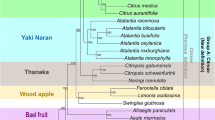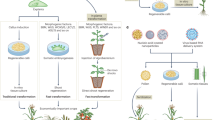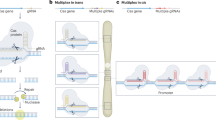Abstract
The development of plants belonging to natural populations of hexaploid Festuca arundinacea with different basic amounts of nuclear DNA was studied. A previous investigation showed that the genome sizes of the populations correlate positively with the mean temperature during the year and with that of the coldest month at the stations. Mitotic cycle time is affected by nuclear DNA content; in a population with a C-value of 6.05 pg, it is 3 h shorter than in a population with a C-value of 8.28 pg. In contrast, the genome size affects neither the proportion of cells entering mitosis in the meristems, nor the enlargement of cells in differentiated leaf tissues. By studying plant development in 30 populations, it was found that their genome size correlates negatively with the seed germination power (P = 0.036) and the early growth of both the seminal root (P = 0.009) and the first foliage leaf (P = 0.099). By contrast, the genome size correlates positively with the height of the highest culm (P = 0.014) and other quantitative characters of the plants at anthesis, as well as with their flowering time (P = 0.037). It is suggested that the variations in the basic amount of nuclear DNA within F. arundinacea have a role in improving the fitness of plants in environments differing in climatic factors such as temperature.
Similar content being viewed by others
Article PDF
References
Bassi, P. 1990. Quantitative variations of nuclear DNA during plant development: a critical analysis. Biol Rev, 65, 185–225.
Bennett, M D. 1972. Nuclear DNA content and minimum generation time in herbaceous plants. Proc R Soc London, Ser, B, 181, 109–135.
Bennett, M D. 1985. Intraspecific variation in DNA amount and the nucleotypic dimension in plant genetics. In: Freeling, M. (ed.) Plant Genetics, A. R. Liss, New York, pp. 283–302.
Bennett, M D. 1987. Variation in genomic form in plants and its ecological implications. New Phytol, 106, 177–200.
Cavallini, A, and Natali, L. 1991. Intraspecific variation of nuclear DNA content in plant species. Caryologia, 44, 93–107.
Cavallini, A, Natali, L, Cionini, G, and Gennai, D. 1993. Nuclear DNA variability within Pisum sativum (Leguminosae): nucleotypic effects on plant growth. Heredity, 70, 561–565.
Ceccarelli, M, Falistocco, E, and Cionini, P G. 1992. Variation of genome size and organization within hexaploid Festuca arundinacea. Theor Appl Genet, 83, 273–278.
Cenci, C A, Ceccarelli, M, Pasqualini, S, Falcinelli, M, and Cionini, P G. 1990. Festuca arundinacea Schreber (Gramineae) in Italy: morphological, anatomical, karyological and biochemical analyses. Webbia, 44, 255–270.
Cionini, P G. 1989. Nuclear DNA changes during plant development. Giorn Bot Ital, 123, 111–121.
Cullis, C A. 1990. DNA rearrangements in response to environmental stress. Adv Genet, 28, 73–97.
Davet-Fresia, M, and Valdeyron, G. 1966. L'umidité des glands de Quercus ilex L.: facteur essential de leur conservation. Naturalia Monspell, Sér Bot, 17, 97–101.
Doolittle, W F, and Sapienza, C. 1980. Selfish genes, the phenotype paradigm and genome evolution. Nature, 284, 601–603.
Jones, R N, and Rees, H. 1982. B chromosomes. Academic Press, London.
Markgraf-Dannenberg, I. 1980. Festuca L. In: Tutin, T. G. et al. (eds), Flora Europaea, vol. 5, pp. 125–133.
Moore, P D. 1985. Nuclear DNA content as a guide to plant growth rate. Nature, 318, 412–413.
Nagl, W. 1990. Gene amplification and related events. In: Bajaj, Y. P. S. (ed.) Biotechnology in Agriculture and Forestry, vol. 11, Springer, Berlin, Heidelberg, New York, pp. 153–201.
Natali, L, Cavallini, A, Cionini, G, Sassoli, O, Cionini, P G, and Durante, M. 1993. Nuclear DNA changes within Helianthus annuus L.: changes within single progenies and their relationships with plant development. Theor Appl Genet, 85, 506–512.
Orgel, L E, and Crick, F H C. 1980. Selfish DNA: the ultimate parasite. Nature, 284, 604–607.
Price, H J, Chambers, K L, and Bachmann, K. 1981. Geographic and ecological distribution of genomic DNA content variation in Microseris douglasii (Asteraceae). Bot Gaz, 142, 415–428.
Price, H J. 1988. DNA content variation among higher plants. Am Missouri Bot Gard, 75, 1248–1257.
Quastler, H, and Sherman, F G. 1959. Cell population kinetics in the intestinal epithelium of the mouse. Exp Cell Res, 17, 420–438.
Wimber, D E. 1960. Duration of the nuclear cycle in Trades-cantia paludosa root tips as measured with 3H-thymidine. Am J Bot, 47, 828–834.
Author information
Authors and Affiliations
Rights and permissions
About this article
Cite this article
Ceccarelli, M., Minelli, S., Falcinelli, M. et al. Genome size and plant development in hexaploid Festuca arundinacea. Heredity 71, 555–560 (1993). https://doi.org/10.1038/hdy.1993.179
Received:
Issue date:
DOI: https://doi.org/10.1038/hdy.1993.179
Keywords
This article is cited by
-
Morphological, cytological and metabolic consequences of autopolyploidization in Hylocereus (Cactaceae) species
BMC Plant Biology (2013)
-
Morphological changes and self-incompatibility breakdown associated with autopolyploidization in Hylocereus species (Cactaceae)
Euphytica (2012)
-
Developmental and environmental variation in genomes
Heredity (2009)
-
Genome size variation and C-band polymorphism inAlstroemeria aurea, A. ligtu andA. magnifica (Alstroemeriaceae)
Plant Systematics and Evolution (1998)
-
Nucleotype and phenotype in Vicia faba
Heredity (1996)



